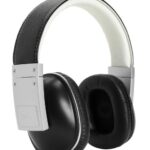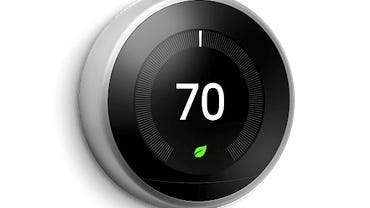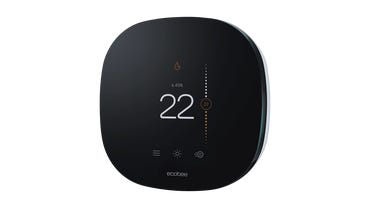
Ecobee SmartThermostat vs. Nest Learning Thermostat
[ad_1]
Smart thermostats can save you time and money when managing your home’s comfort level. They adapt to your daily routine to make sure your heating or cooling is running only when you need it. No more worries about forgetting to turn off the AC before heading out — your smart thermostat has got you covered.
Two of the best on the market are the Ecobee SmartThermostat and the Nest Learning Thermostat. They’re similar in price and share some of the same features. How then do you choose?
This guide will cover each smart thermostat’s features so you can compare. Although Ecobee and Nest thermostats are similar in many ways, some distinct differences may help you make a decision on which smart thermostat is best for you.
Specs:
-
3.3-inch full-color display
-
Available in stainless steel, white, black, polished steel, copper, brass and mirror black
-
Google Assistant voice support, Amazon Alexa, Samsung SmartThings and IFTTT
-
Multi-home support
-
Compatible with 95% of 24V HVAC systems
The Nest Learning Thermostat can efficiently program itself to control your home’s temperature based on your routine.
Contents
- Learning
- Sensors
- Design
- Controls
- Multi-home support
- Installation
- Scheduling and temperature settings
- Sensors
- Sound
- Design
- Controls
- Which is the right one for you?
- Are there alternatives worth considering?
- Ecobee SmartThermostat vs Nest Learning Thermostat FAQ
- What is a c-wire and why do I need one?
- What’s the biggest difference between the Ecobee thermostat vs. Nest Learning Thermostat?
- Do I need a remote sensor for my smart thermostat?
Learning
What makes this smart thermostat so innovative is the learning tech. It watches what you’re doing and follows your schedule to learn how to manage your home’s comfort level better. The goal is to find the balance between efficiency and convenience. Best of all, the whole process happens behind the scenes. For example, each time the Farsight tech greets you by lighting up and giving you: a weather, home temperature and time update, it’s learning more about your movements and schedule.
Sensors
Part of the reason Nest Learning Thermostats are so smart is that they have sensors so they can more efficiently manage your home’s environment. The thermostat has six sensors:
-
Temperature: Monitors your room’s temperature
-
Humidity: Measures a room’s humidity level
-
Proximity: To detect nearby objects
-
Occupancy: Identifies when someone is in the room
-
Ambient light: Measures the amount of light in a room
-
Magnetic: Finds the position of the ring on the thermostat
The Nest Learning Thermostat is integrated with more sensors than other devices. However, they’re only capable of monitoring the area around the thermostat. To solve its limitations, you can always add remote sensors in other rooms. The Nest thermostat is sensor-compatible so that you can add remote temperature sensors, available in a pack of three for oreach.
Design
Nest’s thermostat design is superior to Ecobee’s. The round dial that lights up when someone is in the room, plus the dial in a metal finish in seven colors, gives the thermostat a modern, designer look. You can even change the display to an analog look or keep it digital.
Controls
You can control the thermostat in several ways. Take a hands-off approach and let the device learn your routine to manage your schedule or use Google Assistant/Alexa voice commands. The thermostat is also compatible with the Nest and Google Voice app so that you can control multiple sensors straight from your smartphone. Or you can take the old-school approach of making changes by turning the wall dial and pressing the display.
Multi-home support
Nest’s software sets it apart from other smart thermostats. One of the most useful features for individuals with several devices located in different homes is Multi-home support. You can connect and control up to 20 thermostats per home directly from your account. Signing in with your Nest account allows you to manage thermostats in up to three homes. Google Home supports up to five homes.
Installation
According to Google, installing a Nest Learning Thermostat doesn’t take more than 30 minutes. You can also refer to the Google Nest Learning installation video for a visual installation walkthrough. One critical detail is the c-wire. You can install the thermostat without a c-wire, which isn’t possible with the Ecobee SmartThermostat.
Setting up the initial schedule is also simple — you can do it through the mobile app or on the thermostat itself by following the steps either device gives you. To get started, push the thermostat face, turn the outer dial clockwise until you get to the calendar icon and push the thermostat again when you’re ready to make a selection.
Nest Learning Thermostat Pros:
-
Learns your schedule automatically
-
Stylish, intuitive design
-
Integrated with six sensors
-
Control up to three homes containing up to 20 thermostats each
-
Monitors your HVAC system to catch possible issues early
-
Remote sensor compatible
Nest Learning Thermostat Cons:
Specs:
-
3.5-inch full-color LCD touchscreen
-
Built-in Alexa voice control and speaker
-
Compatible with HVAC systems with up to four stages of heating and two stages of cooling (4H/2C)
-
Includes one remote temperature SmartSensor
The Ecobee SmartThermostat is more than a temperature controller — it has a built-in Alexa speaker and can connect to a Bluetooth speaker to add music functionality.
Scheduling and temperature settings
The Ecobee SmartThermostat also learns and adapts your schedule to reduce your home’s energy usage. The scheduling functionality is more calendar-based, which may be more familiar to set up than Nest’s adaptive style.
Ecobee has a unique feature called Follow Me. If you have remote sensors installed in other rooms, they work together to find the rooms people are in to adjust the temperature setting accordingly.
Sensors
Ecobee comes with one remote temperature sensor that can be installed in a different room. Besides the included sensor, the thermostat has four integrated sensors for:
-
Humidity
-
Occupancy
-
Proximity
-
Temperature
Sound
What sets the Ecobee apart from the Nest thermostat is the sound functionality. Ecobee has an integrated Alexa speaker and microphone, claiming it’s the world’s first thermostat that’s integrated with Alexa — and now Siri. In addition, Spotify is now included so you can listen to your favorite tunes directly from the thermostat.
Before you get swayed by the idea of piping music from your Ecobee, make sure you’d actually tune in to Spotify from the thermostat’s location. It may not be as practical if the thermostat is located in a hallway. Nevertheless, the thermostat can also connect to a Bluetooth speaker to provide better sound quality from a more optimal location.
Design
Ecobee’s thermostat doesn’t have the most attractive design, especially when compared to the Nest. However, the large display makes it easier to program the thermostat, change the settings and view reports. There are no body color options, although adding color to an already large wall device that lacks sophistication may be a mistake.
Controls
Ecobee has its own mobile app that allows you to program and adjust your home’s settings from a smart device. Or you can program your thermostat straight from the wall device. As mentioned already, Siri and Alexa are built-in, so you can command your thermostat to make changes. And if you have an Apple HomePod or HomePod mini, you can pair it with the thermostat to integrate it with your smart home automation.
Ecobee SmartThermostat Pros:
-
Includes one remote sensor
-
Integrated Alexa speaker
-
Compatible with Google Assistant and Siri
-
Supports Spotify
-
Connects to Bluetooth speakers
Ecobee SmartThermostat Cons:
Which is the right one for you?
Making a choice between Nest and Ecobee’s most feature-packed thermostats isn’t easy. They’re both state-of-the-art with machine learning. They can both expand by adding remote temperature sensors. Ecobee includes one with the thermostat — you’d need to buy one separately if you choose Nest.
If you still can’t decide between an Ecobee thermostat or Nest Learning Thermostat, there are three ways to approach the decision. You’ll need to ask yourself if having a built-in music speaker is something you’d use. If so, the Ecobee SmartThermostat is the one.
However, how important is design to you? The Nest thermostat’s seven color finishes are stunning and include bronze and copper. If the device is mounted in a prominent position, you may want to choose the Nest Learning Thermostat.
The last decision to make is about your home’s wiring. If you have a C-wire installed, then you can choose either thermostat. However, if you don’t, the Nest thermostat is your only option since it doesn’t need to connect to one to work. You could always have an electrician add a c-wire connection if you’re sold on the Ecobee, but modifying wiring may not be possible if you rent.
Are there alternatives worth considering?
This review compares what we believe are the two best smart thermostats available right now. The alternatives lack many of the features reviewed.
However, if you must compare alternatives to feel comfortable about your final decision, consider the following:
-
. The T9 is less expensive than Ecobee and Nest’s thermostats reviewed and is compatible with Google Assistant and Alexa.
-
. If the Nest Learning and Ecobee SmartThermostat have more features than you need and are too complex for you to understand, the Nest Thermostat is a simpler, pared-down smart thermostat.
-
. If you like everything about the Ecobee SmartSensor except for the Spotify/speaker integration, the Ecobee3 lite is a good alternative. You’ll save some money.
Ecobee SmartThermostat vs Nest Learning Thermostat FAQ
What is a c-wire and why do I need one?
A C-wire stands for ‘common wire’. Most smart thermostats need to connect to the c-wire to function. However, the c-wire isn’t always installed unless you live in a recently-built house. The wire runs from your 24V HVAC system to carry continuous power to your smart thermostat. The smart device can’t remain connected to your home network to keep the thermostat running without it.
What’s the biggest difference between the Ecobee thermostat vs. Nest Learning Thermostat?
If you’re comparing the Ecobee SmartThermostat and Nest Learning Thermostat, the biggest difference is the built-in Alexa speaker in the Ecobee. The manufacturer claims that it’s the first smart thermostat in the world to add in a built-in speaker and Alexa. In addition, the thermostat is compatible with Spotify to stream music. The thermostat basically becomes a wall-mounted speaker that can control your home’s temperature.
Do I need a remote sensor for my smart thermostat?
You don’t need to buy a remote temperature sensor for your home’s smart thermostat. However, having one expands your smart thermostat’s capabilities. Think about it this way — a smart thermostat can only provide information for the room it’s located in. A remote temperature sensor can be placed in a different room, such as a bedroom upstairs so that you can monitor two zones instead of one.
If your home has areas that you frequently use that tend to get overly warm or drafty, monitoring the temperature in the specific room can help you make adjustments to make the zone more comfortable.
[ad_2]
Source link







